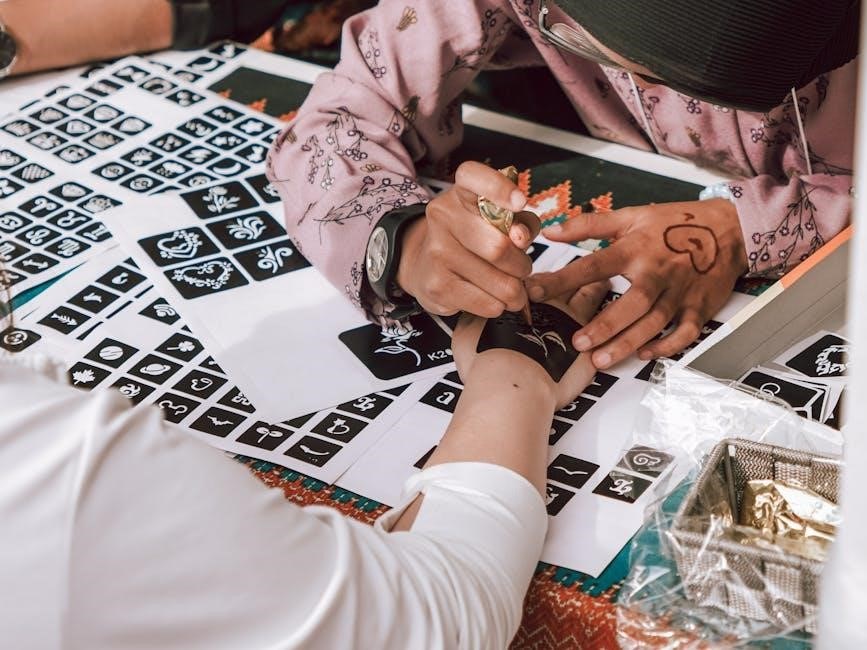Tattooing for Beginners: A Comprehensive Guide
Embark on your journey into the art of tattooing with our comprehensive guide. This resource is tailored for beginners, offering insights into basic techniques, essential equipment, and safety standards. Learning from books can provide valuable knowledge of the art form.
Tattooing, an age-old art form, has surged in popularity, evolving with modern techniques and styles. This guide introduces aspiring artists to the tattooing world, emphasizing the importance of mastering fundamental skills before working on real skin. Tattooing can be a fulfilling career and a stable way to make a living as an artist.
Drawing skills are paramount, influencing design quality and client attraction, as well as preventing you from copying other artists. Practice on fake skins is crucial for skill development in lining, shading, and color packing. Understanding equipment and safety is key to unleashing your potential.
Lining forms the tattoo’s basic structure, while shading adds depth and dimension. Color packing brings the tattoo to life, with each element requiring dedicated practice. With dedication and the right guidance, anyone can embark on this captivating artistic path.
Essential Equipment for Beginners
For aspiring tattoo artists, acquiring the right equipment is crucial for a safe and effective learning experience. A tattoo machine, often incorrectly referred to as a “tattoo gun,” is the primary tool. Beginners should start with a reliable machine designed for practice and ease of use.
Needles are essential, with various configurations serving different purposes. Practice skins provide a safe platform for honing skills without risking real clients. A power supply ensures consistent energy to the tattoo machine, while tattoo ink delivers the desired colors and shades.
Sterile gloves, masks, and surface disinfectants are non-negotiable for maintaining a hygienic environment. Stencil paper and transfer solutions aid in accurately transferring designs onto the skin. Finally, distilled water and rinse cups are necessary for cleaning needles during tattooing, ensuring color purity and hygiene.
Invest in quality equipment to establish a solid foundation for your tattooing journey.
Basic Tattooing Techniques
Mastering basic tattooing techniques is crucial for any aspiring tattoo artist. These techniques form the foundation upon which all advanced skills are built, ensuring the creation of solid, long-lasting tattoos. Tattooing can be broken down into three fundamental elements: lining, shading, and color packing.
Lining involves creating the outline or shape of the tattoo design. This is often the first step in the tattooing process and requires precision and steady hands. Shading adds depth and dimension to the tattoo by creating areas of varying darkness. This technique relies on using different grey wash dilutions to achieve different values.
Color packing involves filling in sections of the tattoo with solid colors. This requires a consistent hand and proper technique to ensure the color appears vibrant and uniform. Each of these techniques requires practice and understanding of needle depth, machine speed, and hand movement.
Consistent practice on practice skins is vital for developing muscle memory and refining these essential skills.
Lining Techniques
Lining techniques are fundamental to tattooing, forming the outline and structure of the design. Mastering this technique is essential for creating clean, readable, and visually appealing tattoos. Straight lines are notoriously difficult to achieve, but several tricks can aid in this process.
Establishing stability is crucial. Use three points of contact to steady your hand. Stretching the skin taut with your non-dominant hand is also important, move the machine with the line. Whether you pull the line toward you or push it away is up to you.
For longer lines, create the illusion of fluidity by flicking the needle up at the end of each stroke to create a tapered point, then swinging the machine back in at an angle to continue. Varying line weights adds dimension and readability to the tattoo. Use thicker lines for the main outline and thinner lines for details.

Practice and patience are key to mastering lining techniques and achieving professional-looking results.
Creating Straight Lines
Achieving perfectly straight lines is a challenge for beginner tattoo artists. Mastering this skill requires practice and a solid understanding of technique. One crucial element is stability. Create three points of contact to steady your hand during the tattooing process. This involves bracing your hand against the client’s skin or a stable surface.
Stretching the skin taut is equally important. Use the thumb and forefinger of your non-dominant hand to stretch the skin in the direction you intend to tattoo. This creates a smooth, even surface, reducing the risk of shaky lines. Maintain a consistent angle with the needle and move the cartridge in the direction of the line.
Avoid moving the needle from side to side across the skin. Practice on fake skin to refine your technique and develop muscle memory. With dedication and the right approach, you can conquer the challenge of creating straight lines.
Varying Line Weights
An essential aspect of professional tattooing lies in the ability to manipulate line weights, adding depth and dimension to your designs. Varying line weights creates visual interest and enhances the overall readability of a tattoo. Designs with uniform lines can appear flat and lack detail.
Thicker, bolder lines are ideal for outlining the main structure of the design, providing a strong foundation. Thinner lines, on the other hand, serve to fill in details and create subtle nuances. For example, when tattooing a tree, use thicker lines for the branch outline and finer lines to depict the bark’s texture.

Experiment with different needle configurations to achieve the desired line weights. Larger needle groupings will produce thicker lines, while smaller groupings will create finer lines. Mastering this technique elevates your tattoos from simple outlines to dynamic works of art. Practice on fake skin to perfect your control over line weights.
Shading Techniques
Shading is a crucial technique in tattooing that adds depth and dimension to your artwork, creating the illusion of three-dimensionality. By strategically applying darker tones to certain areas, you can make elements appear closer or further away, enhancing the overall visual impact. A design without shading appears flat and lifeless, lacking the subtle nuances that bring it to life.
Several shading techniques exist, each offering a unique approach to achieving different effects. The chosen method depends on the desired outcome and the artist’s personal style. One common technique involves using diluted ink to create gradients, gradually transitioning from dark to light. Another involves stippling, where small dots are strategically placed to build up shading.
Understanding needle depth and machine speed is crucial for effective shading. Practicing on fake skin allows you to experiment with different techniques and settings without the risk of damaging real skin. Mastering shading transforms your tattoos into dynamic, visually compelling works of art.
Color Packing Techniques
Color packing is the art of filling a defined area of a tattoo with solid, vibrant color. This technique ensures the color appears uniform and saturated, making the tattoo visually striking and long-lasting. Effective color packing prevents a patchy or faded appearance, which can detract from the overall design.
The key to successful color packing lies in using the correct needle groupings and machine settings. Larger magnum needles are often preferred for covering larger areas quickly and efficiently. It’s crucial to maintain a consistent hand speed and needle depth to achieve an even distribution of pigment.
Preventing color contamination is essential when working with multiple shades. Wiping darker colors over lighter areas can result in staining, creating a muddy or dull appearance. Always work from darkest to lightest colors to avoid this issue. Using separate needles for each color, or thoroughly cleaning the needle between colors, also helps maintain color purity. Proper rinsing and careful application are essential for achieving vibrant, clean color in your tattoos.
Drawing Skills for Tattoo Artists
Strong drawing skills are fundamental for any aspiring tattoo artist. Proficiency in drawing directly impacts the quality of tattoo designs and is essential for securing a position in a reputable tattoo shop. The ability to create compelling, original designs attracts more clients and builds a strong portfolio.
Developing drawing skills involves mastering various techniques, including line work, shading, and composition. Practicing regularly helps in understanding form, perspective, and the interplay of light and shadow. These elements are crucial for translating ideas into visually appealing tattoo designs.
Furthermore, drawing helps develop a unique artistic style, setting you apart from other artists. It also provides a solid foundation before working on skin, allowing you to experiment with different designs and techniques without the risk of damaging a client’s skin. Original designs showcase your creativity and prevent unintentional plagiarism, which is highly frowned upon in the tattoo industry.
Using Practice Skins
Before tattooing real skin, using practice skins is essential for honing your skills. Practice skins allow you to develop your techniques without risking your reputation by creating subpar tattoos early in your career. These skins mimic the texture and appearance of real skin, providing a realistic canvas for practicing various tattooing techniques.
Working with practice skins allows you to master lining, shading, and color packing. You can experiment with different needle configurations, ink types, and machine settings, all without the pressure of working on a live client. This experimentation helps you understand how different factors affect the final tattoo.
Furthermore, practice skins offer the opportunity to refine your hand speed, depth control, and overall precision. Consistent practice on these surfaces builds confidence and muscle memory, preparing you for the challenges of tattooing real skin. Using practice skins is an invaluable step in becoming a skilled and reputable tattoo artist, ensuring that your initial tattoos on clients are of the highest quality.
Understanding Needle Configurations
Grasping needle configurations is crucial for any aspiring tattoo artist. Different needle groupings serve specific purposes, impacting the final look of the tattoo. Round liners (RL) are tightly packed needles used for precise lines and intricate details. The smaller the number, the finer the line.
Round shaders (RS) are loosely grouped needles, ideal for soft shading and filling small areas. Magnum needles (M1, M2) are arranged in a row, perfect for color packing and large shading areas. They distribute ink evenly, minimizing skin trauma. Curved magnums (CM) follow the skin’s contour, providing smoother shading transitions.
Stack magnums are tightly packed magnum needles, ideal for blending and achieving gradients. Understanding the application of each configuration allows artists to create depth, texture, and visual interest in their tattoos. Experimenting with different needle types on practice skins is crucial for mastering their individual characteristics and achieving the desired effects in your artwork. This knowledge is vital for producing high-quality, visually compelling tattoos.
Hygiene and Safety Standards

Upholding stringent hygiene and safety standards is paramount in tattooing, ensuring the well-being of both artist and client. Before each tattoo session, thoroughly sanitize your workspace with a broad-spectrum disinfectant. Cover all surfaces with disposable barriers to prevent cross-contamination. Always use single-use, sterile needles from sealed packaging.
Dispose of used needles in a designated sharps container to prevent accidental injuries. Wear disposable gloves throughout the tattooing process, changing them if they become torn or contaminated. Prepare the client’s skin by shaving the area and cleansing it with an antiseptic solution. During the tattoo, wipe away excess ink and blood with sterile gauze or paper towels.
Properly dispose of all contaminated materials after each session. Educate clients on aftercare procedures to minimize the risk of infection. Obtain informed consent from clients before beginning any tattoo. Maintain a sterile environment to avoid infections, allergic reactions, and other complications. Prioritizing hygiene and safety builds trust and ensures a positive experience for everyone involved.
Developing Your Tattoo Style
Cultivating a unique tattoo style is a journey of self-discovery and artistic exploration. Begin by immersing yourself in diverse art forms, drawing inspiration from various cultures, historical periods, and personal experiences. Experiment with different tattoo styles, such as traditional, neo-traditional, realism, geometric, and abstract, to find what resonates with you.
Study the works of renowned tattoo artists, analyzing their techniques, composition, and use of color. Practice replicating their styles to understand the underlying principles, but avoid direct imitation. Instead, use these exercises as a foundation for developing your own distinctive approach. Incorporate elements of your personality, interests, and values into your designs.
Continuously refine your skills through practice and experimentation. Seek feedback from experienced artists and fellow enthusiasts to gain valuable insights and identify areas for improvement. Embrace constructive criticism and use it to push your creative boundaries. Remember that developing a unique style takes time and dedication. Be patient, persistent, and true to your artistic vision.
Learning from Tattoo Technique Books
Tattoo technique books serve as invaluable resources for aspiring and experienced artists alike, offering a wealth of knowledge and insights into the art form. These books cover a wide range of topics, from the basics of setting up a tattoo studio to advanced techniques for creating stunning and lasting tattoos.
Begin by exploring books that focus on fundamental tattooing principles, such as outlining, shading, and color packing. Pay close attention to the step-by-step instructions and illustrations, practicing each technique on practice skins before attempting them on real skin. As you progress, delve into books that explore specific tattoo styles, such as traditional, neo-traditional, realism, and geometric.
Study the works of renowned tattoo artists featured in these books, analyzing their techniques, composition, and use of color. Use this knowledge to refine your own skills and develop your unique artistic style. Remember that tattoo technique books are not meant to be followed blindly. Instead, use them as a guide to explore your own creativity and push the boundaries of the art form.
Avoiding Common Mistakes
Aspiring tattoo artists often make mistakes that can hinder their progress. One common error is neglecting proper hygiene and safety protocols, which can lead to infections and complications for clients; Always sterilize equipment thoroughly and use disposable needles to prevent cross-contamination. Another mistake is rushing the learning process.
Mastering the fundamentals of tattooing, such as lining, shading, and color packing, takes time and dedication. Avoid skipping steps or attempting advanced techniques before you’re ready. Furthermore, many beginners struggle with depth control, either going too deep and causing blowouts or not going deep enough and resulting in faded tattoos.

Practice consistently on practice skins to develop a feel for the right depth. Drawing skills are also crucial for tattoo artists, as they enable them to create original designs and execute them effectively. Neglecting drawing practice can limit your artistic potential and lead to poorly designed tattoos.
Finally, avoid copying other artists’ work without permission, as this is unethical and can damage your reputation. Instead, use their work as inspiration to develop your own unique style.
